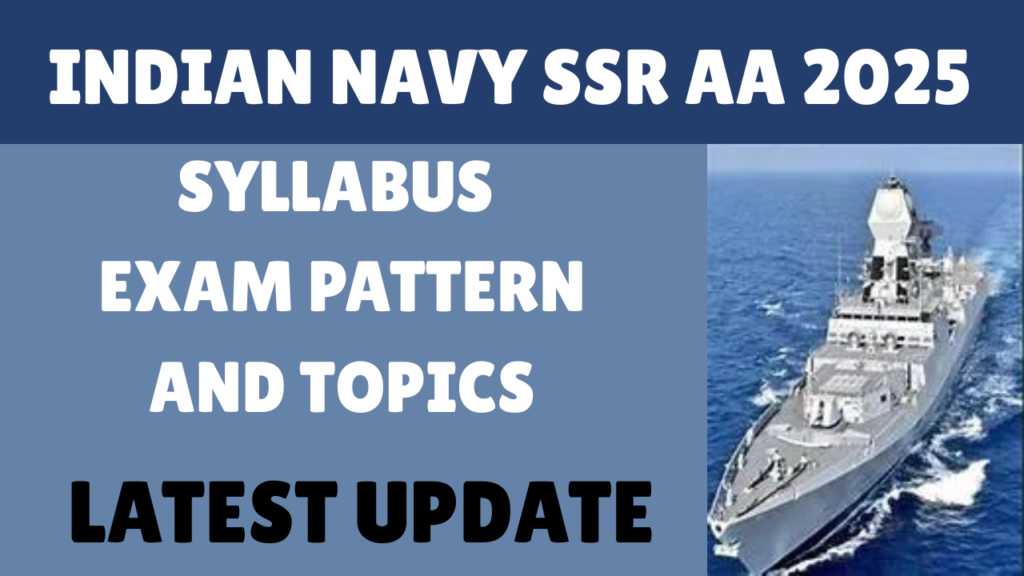Indian Navy SSR AA Exam Pattern 2025
Before you take the exam, know the pattern. The test is online and has 4 sections. You will get the paper in Hindi and English.
Each section has 25 questions and is worth 25 marks. You get 60 minutes for each section.
Here’s the easy-to-read table:
| Subject | Questions | Marks | Time |
|---|---|---|---|
| English | 25 | 25 | 60 mins |
| Science | 25 | 25 | 60 mins |
| Mathematics | 25 | 25 | 60 mins |
| General Knowledge | 25 | 25 | 60 mins |
| Total | 100 | 100 | 4 hours |
- 1 mark for a right answer.
- 0.25 marks off for a wrong answer.
The questions will be like what you learn in 12th grade. So, try your best in all subjects to move on to the next stage!
Physical Fitness Test (PFT)
For this job you have to pass the Physical Fitness Test. Here is what you need to do:
- Running 1.6 km in 7 minutes.
- Do 20 sit-ups.
- Do 10 push-ups.
If you’ve done sports or swimming, it could help.
Medical Standards
There is a medical check to make sure you are healthy. Here’s what you need:
- You need to be at least 157 cm tall.
- Your chest must expand by at least 5 cm.
- You need to be in good health (physically and mentally).
Recruitment Process: SSR and AA
- AA (Artificer Apprentice) candidates are selected from all over India.
- SSR (Senior Secondary Recruit) candidates are selected based on state-wise scores.
Indian Navy SSR AA Syllabus 2025

The exam checks your basic knowledge from 11th and 12th grade subjects. Here’s the complete syllabus in a simple table format:
Science Syllabus
| Subject | Topics |
|---|---|
| Physics | – Physical world and Measurement |
| – Kinematics | |
| – Laws of Motion | |
| – Work, Energy, and Power | |
| – Electricity and its Applications | |
| – Mechanics of Solids and Fluids | |
| – Force and Gravitation | |
| – Heat and Thermodynamics | |
| – Oscillations and Waves | |
| – Current Electricity | |
| – Magnetism | |
| – Metals and Non-Metals | |
| – Sound and Wave | |
| – Electromagnetic Induction | |
| – Alternating Current | |
| – Dual Nature of Matter and Radiations | |
| – Optics | |
| – Atomic Nucleus | |
| – Solid and Semiconductor Devices | |
| – Principles of Communication | |
| Chemistry | – Atomic Structure |
| – Some Basic Concepts of Chemistry | |
| – Chemical Bonding | |
| – States of Matter | |
| – Carbon and its Compounds | |
| – Periodic Table | |
| – Acids, Bases & Salts | |
| – Metals and Non-Metals | |
| Basic Science | – Food and Nutrition |
| – Health Physiology | |
| – Human Diseases | |
| – Basic Computer Science |
Mathematics Syllabus
| Topics |
|---|
| – Relations and Functions |
| – Logarithms |
| – Complex Numbers |
| – Quadratic Equations |
| – Sequences and Series |
| – Trigonometry |
| – Introduction to Three Dimensional Geometry |
| – Probability Function |
| – Limits and Continuity |
| – Differentiation |
| – Applications of Derivatives |
| – Cartesian System of Rectangular Coordinates |
| – Straight Lines, Family of Straight Lines |
| – Circles |
| – Conic Sections |
| – Permutations and Combinations |
| – Vectors |
| – Exponential and Logarithmic Series |
| – Sets and Set Theory |
| – Statistics |
| – Indefinite Integrals |
| – Binomial Theorem |
| – Matrices, Determinants, Definite Integrals |
English Syllabus
| Topics |
|---|
| – Passage |
| – Prepositions |
| – Sentence Correction |
| – Active to Passive/Passive to Active Voice |
| – Direct to Indirect/Indirect to Direct |
| – Verbs/Tenses/Non-Finite |
| – Punctuation |
| – Substituting Phrasal Verbs for Expressions |
| – Synonyms and Antonyms |
| – Meanings of Difficult Words |
| – Use of Adjectives |
| – Compound Prepositions |
| – Determiners (Use of A, The, Any, etc.) |
| – Use of Pronouns |
General Knowledge Syllabus
| Topics |
|---|
| – Culture and Religion |
| – Geography (Soil, Rivers, Mountains, Ports) |
| – Freedom Movement |
| – Sports (Championships, Winners, Terms, Players) |
| – Defence |
| – Wars and Neighbours |
| – Current Affairs |
| – Spatial, Numerical, Reasoning, and Associative Ability |
| – Important National Facts about India |
| – Heritage (Arts, Dance, History, Languages) |
| – National Symbols (Bird, Animal, Sport, Flower) |
| – Civics (Constitution, Culture, Religion, etc.) |
